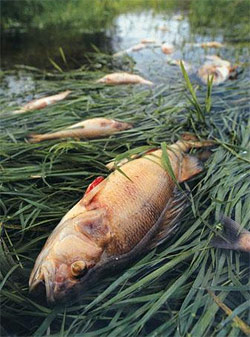 Over
the past 30 years, the U.S. has substantially reduced industrial and chemical pollution
from point sources, e.g., pollution with a clearly identifiable source, such as
a discharge pipe or conduit.
Over
the past 30 years, the U.S. has substantially reduced industrial and chemical pollution
from point sources, e.g., pollution with a clearly identifiable source, such as
a discharge pipe or conduit.
Tackling the more pervasive nonpoint sources - runoff from major urban areas and
agricultural fields - has proven more difficult, and much still needs to be done
to control this type of pollution. Potentially harmful chemical pollution and excess
nutrient runoff remain top concerns for environmental and land managers in coastal
areas.
CCEHBR scientists are actively engaged in research to improve our ability
to detect and predict changes in the quality of coastal resources affected by such
disturbances. Research in
CCEHBR's Estuaries
and Land Use branch includes evaluation of lethal and sublethal effects
of single contaminants and contaminant mixtures, toxicity-testing with single species,
and testing in controlled conditions in mesocosms to assess contaminant impacts
at the community level. Other health assessment research is directed at discerning
the impact of environmental and anthropogenic stressors on bottlenose dolphin populations
(Marine Mammals).
The Coastal Ecology Program of
CCEHBR’s Protected Areas and Resources Branch also conducts field studies to assess the spatial extent, severity, and sources of pollutant impacts in key ecosystems throughout the U.S. including estuaries, coastal-ocean waters, coral reefs, and special areas with protected status such as National Marine Sanctuaries and National Estuarine Research Reserve System sites. In addition to field assessments, research efforts also include the development of related ecological indicators and other diagnostic tools for assessing and forecasting pollutant impacts in coastal ecosystems. Read more about CEP’s pollution-related research as part of its Regional Ecological Assessments.